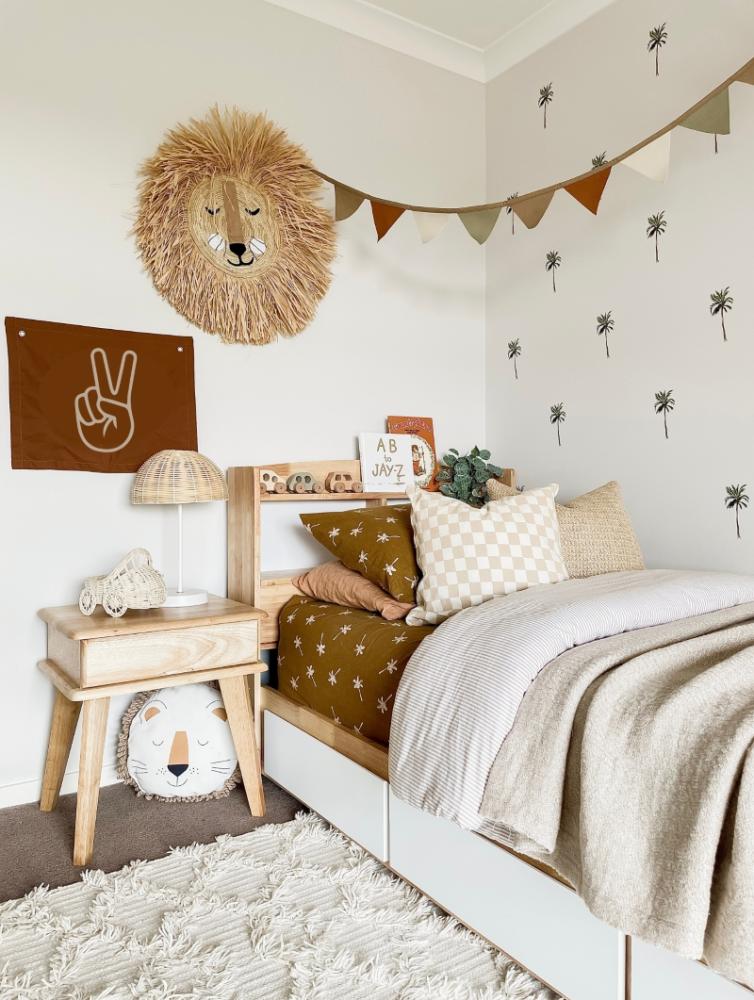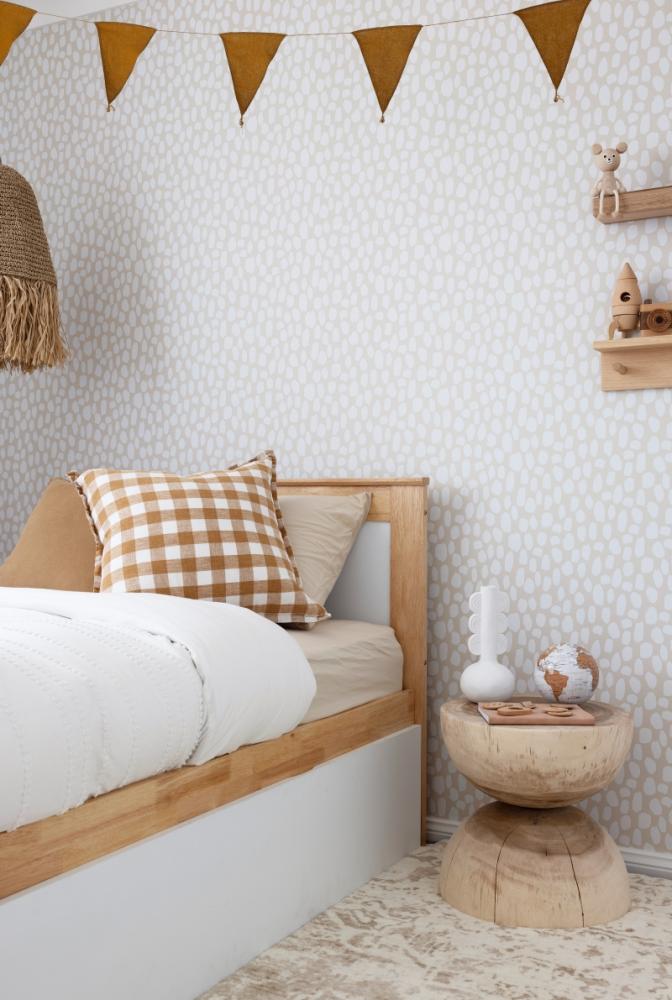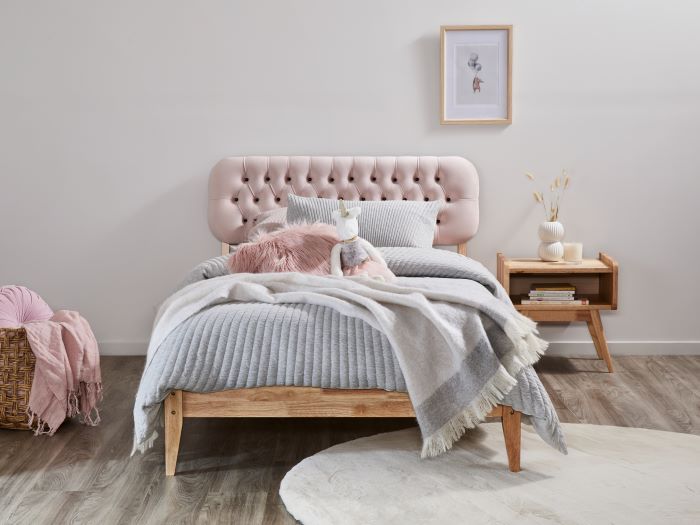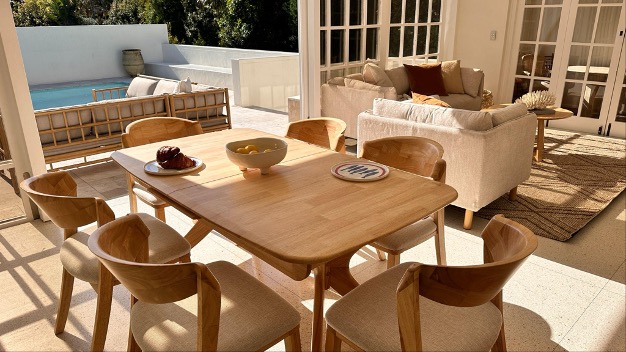Ensuring your child gets a good night’s sleep is crucial for their overall health and development. A well-designed sleep space and environment can make a big difference in how easily your child falls asleep and stays asleep. In this guide, we'll cover essential tips on setting up the room, choosing the right bed and mattress, and creating a soothing atmosphere to create that safe sleep space for your child. .

Image source: B2C Furniture X _our.little.story
The Importance of a Comfortable Bed and Mattress
Choosing the Right Bed
Selecting the right bed can significantly impact your child’s sleep quality. Here’s a quick look at options based on age:
- Infants and Toddlers: A baby crib or toddler bed is ideal. Ensure it meets safety standards and fits well in your room.
- Preschoolers: Transition to a single or double bed with safety rails if needed.
- School-Aged Children: A single, double or king single full sized bed provides space to grow. Consider a bed with built-in storage to keep the room tidy.
Choosing the right bed helps ensure that your child sleeps comfortably and securely, promoting better rest and fewer interruptions.
Selecting a Quality Mattress
A good quality mattress is key to a good night’s sleep. Here’s why and how to choose one:
- Support: A mattress that offers proper support helps maintain your child's posture and reduces discomfort.
- Comfort: Look for a mattress that balances firmness and softness. It should feel comfortable but not too soft.
- Material: Opt for hypoallergenic materials if your child has allergies.
A high-quality mattress can help prevent sleep problems and ensure your child wakes up feeling rested. We did an in-depth blog recently about all types of mattresses and what the benefits are for each style, be sure to check it out for further information!

Image source: B2C Furniture X k.estudio__
Optimising the Room Environment for a Better Sleep Space
Ideal Room Temperature
When considering what type of environment is most conducive for children to sleep in, the temperature of your child’s room can greatly affect their sleep patterns.
- Optimal Temperature: Aim for a room temperature between 18-21°C (65-70°F). This range helps your child stay comfortable throughout the night.
- Maintaining Temperature: Use a fan or a thermostat to keep the temperature consistent. Avoid heavy bedding that can overheat your child.
Keeping the room at the right temperature can help your child fall asleep faster and stay asleep longer.
Lighting Solutions
Lighting plays a crucial role in how well your child sleeps.
- Night Lights: Soft, dim lights can help comfort children who are afraid of the dark.
- Blackout Curtains: These can block out external light and help your child sleep more soundly.
- Lighting Options: Choose lighting that can be dimmed or adjusted according to bedtime needs.
Proper lighting can create a calming environment that makes it easier for your child to relax and fall asleep.
Managing Noise Levels
Noise can disrupt sleep, so managing it is important for a good night’s rest.
- White Noise: Machines or apps that produce white noise can mask disruptive sounds and help your child stay asleep.
- Quiet Environment: Minimise loud noises and keep the room as quiet as possible during sleep times.
Creating a peaceful environment helps your child remain undisturbed throughout the night.
Organising the Room
A well-organised room also contributes to a calming environment and due to this, promotes a calming sleep environment. .
- Clutter-Free Space: Keep the room tidy to create a serene atmosphere.
- Organising Toys: Store toys and other items out of sight, possibly in bins or shelves, to reduce distractions at bedtime.
A clean, organised room helps your child feel more relaxed and ready for sleep.

Image source: B2C Furniture X haausdesign
Additional Tips for Building a Safe Sleep Space
Establishing a Bedtime Routine
Some great sleep tips for kids include a consistent bedtime routine that helps signal to your child that it’s time to wind down.
- Routine: Set a regular bedtime and follow a sequence of calming activities like reading a book or taking a warm bath.
- Consistency: Stick to the routine every night to help your child’s body adjust.
A predictable routine can make bedtime smoother and help your child settle into sleep more easily.
Using Comfort Objects
Comfort objects can provide a sense of security and help your child feel more at ease.
- Stuffed Toys/Animals: These can be soothing and provide a sense of companionship.
- Blankets: A soft, favourite blanket can also be comforting.
Choose comfort items that are safe and appropriate for your child’s age and preferences.
Avoiding Screen Time Before Bed
Screen time before bed can interfere with your child’s sleep patterns.
- Effects: The blue light from screens can disrupt the production of melatonin, making it harder for your child to fall asleep.
- Alternatives: Opt for quiet activities like reading or listening to calming music before bedtime.
Reducing screen time helps your child transition to sleep more naturally.

Image source: B2C Furniture
Upgrading Your Mattress with B2C Furniture
Although we don’t have all the solutions to solve your child's sleep problems, creating the perfect sleep environment and a safe sleep space involves several key elements: a comfortable bed and mattress, a well-organised room, and effective sleep strategies. Each aspect plays a role in ensuring your child gets the restful sleep they need.
When asking the question “what is used to create a safe sleep environment”, explore our amazing range of furniture and the Kids Beds Collection Page and the Kids Mattresses Page for options that can help enhance your child's sleep space. Investing in the right furniture and creating a sleep-promoting environment can make a significant difference in your child's sleep quality.





